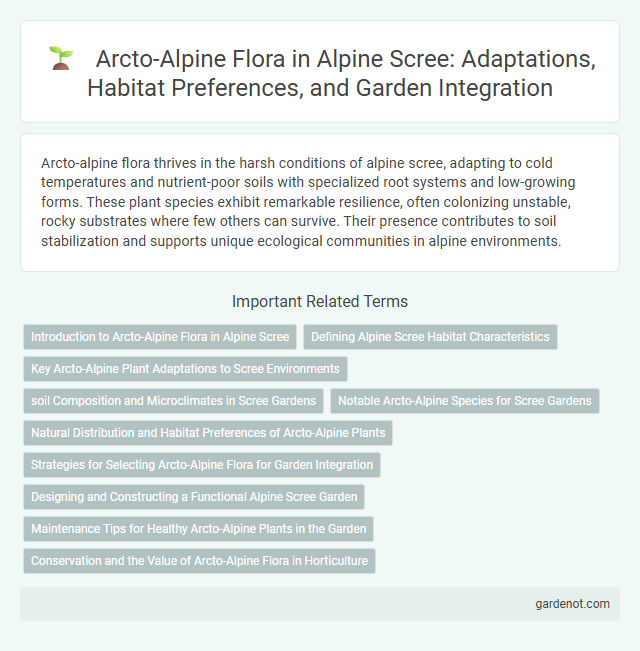Arcto-alpine flora thrives in the harsh conditions of alpine scree, adapting to cold temperatures and nutrient-poor soils with specialized root systems and low-growing forms. These plant species exhibit remarkable resilience, often colonizing unstable, rocky substrates where few others can survive. Their presence contributes to soil stabilization and supports unique ecological communities in alpine environments.
Introduction to Arcto-Alpine Flora in Alpine Scree
Arcto-alpine flora in alpine scree exhibits unique adaptations to harsh climatic conditions, such as extreme cold, strong winds, and nutrient-poor soils. This specialized vegetation includes hardy mosses, lichens, and low-growing vascular plants that anchor in loose rocky substrates, playing a crucial role in soil stabilization and ecological succession. The biodiversity of arcto-alpine species contributes significantly to the resilience and functionality of alpine scree ecosystems across high mountain ranges.
Defining Alpine Scree Habitat Characteristics
Alpine scree habitats are characterized by loose, fragmented rock slopes typically found above the tree line in arctic and alpine regions, providing a unique environment for specialized Arcto-alpine flora. These plants exhibit adaptations such as deep root systems and cushion-like growth forms to withstand extreme temperature fluctuations, nutrient-poor substrates, and high solar radiation. The dynamic and unstable nature of scree slopes creates microhabitats that support a distinct assemblage of hardy species including Saxifraga oppositifolia and Silene acaulis, key indicators of Arcto-alpine ecosystems.
Key Arcto-Alpine Plant Adaptations to Scree Environments
Arcto-alpine flora in scree environments exhibit key adaptations such as cushion-like growth forms that reduce wind exposure and conserve moisture. Root systems are often extensive and deep, anchoring plants securely in unstable, rocky substrates while maximizing nutrient uptake. These plants also display physiological tolerance to extreme temperature fluctuations and desiccation common in alpine scree habitats.
soil Composition and Microclimates in Scree Gardens
Arcto-alpine flora thriving in alpine scree benefits from the unique soil composition characterized by well-drained, coarse mineral substrates with low organic matter, fostering specialized nutrient uptake strategies. Microclimates within scree gardens exhibit significant variation in temperature, moisture, and wind exposure due to rapid drainage and crevice shading, which create localized habitats supporting diverse plant communities. The interplay between mineral-rich, acidic soils and microclimatic niches enables the survival of hardy species adapted to harsh alpine environments.
Notable Arcto-Alpine Species for Scree Gardens
Notable Arcto-Alpine species for scree gardens include Dryas octopetala, Saxifraga oppositifolia, and Silene acaulis, which thrive in cold, rocky environments with excellent drainage. These species exhibit adaptations such as cushion-like growth forms and deep root systems, enabling survival in nutrient-poor, unstable scree substrates. Cultivating these plants enriches alpine scree gardens by introducing biodiversity and maintaining ecological authenticity.
Natural Distribution and Habitat Preferences of Arcto-Alpine Plants
Arcto-alpine plants primarily thrive in high-altitude or high-latitude environments characterized by cold temperatures, short growing seasons, and well-drained, rocky substrates typical of alpine scree slopes. Their natural distribution spans arctic tundras and alpine zones across circumpolar regions of North America, Europe, and Asia, where they exhibit adaptations for nutrient-poor, unstable scree habitats. These plants prefer exposed, sunlit areas with minimal soil development, often colonizing crevices and loose rock debris that provide protection from extreme weather conditions and facilitate water drainage.
Strategies for Selecting Arcto-Alpine Flora for Garden Integration
Selecting Arcto-Alpine flora for garden integration requires understanding their adaptations to harsh alpine scree environments, such as tolerance to cold temperatures, poor soil nutrients, and intense sunlight. Prioritize species with deep root systems and drought resistance, like Saxifraga oppositifolia and Silene acaulis, to ensure stability and survival in scree substrates. Incorporating native plants enhances ecological authenticity and supports pollinators specialized in alpine habitats.
Designing and Constructing a Functional Alpine Scree Garden
Designing and constructing a functional alpine scree garden involves selecting Arcto-alpine flora species adapted to harsh, rocky environments with excellent drainage and low nutrient availability. Key plants include Saxifraga oppositifolia, Dryas octopetala, and Silene acaulis, which thrive in well-drained scree substrates and withstand extreme temperature fluctuations. Incorporating angular rocks and gravel mimics natural scree slopes, promoting root stability and moisture regulation essential for the survival of these specialized alpine plants.
Maintenance Tips for Healthy Arcto-Alpine Plants in the Garden
Arcto-alpine flora thrives in well-drained, rocky soils mimicking natural scree environments with low nutrient levels and high mineral content. To maintain healthy plants, ensure consistent moisture without waterlogging by using gravelly substrates that enhance aeration and prevent root rot. Regularly remove competing weeds and apply minimal organic fertilizer to support slow growth while preserving the natural alpine conditions crucial for these specialized species.
Conservation and the Value of Arcto-Alpine Flora in Horticulture
Arcto-alpine flora thrives in harsh alpine scree environments, exhibiting unique adaptations that contribute to biodiversity and ecosystem stability. Conservation efforts prioritize protecting these specialized species from habitat loss and climate change, ensuring genetic diversity critical for resilience. In horticulture, arcto-alpine plants are valued for their hardiness and ornamental appeal, promoting sustainable gardening practices and enhancing alpine-themed landscapes.
Arcto-alpine flora Infographic

 gardenot.com
gardenot.com